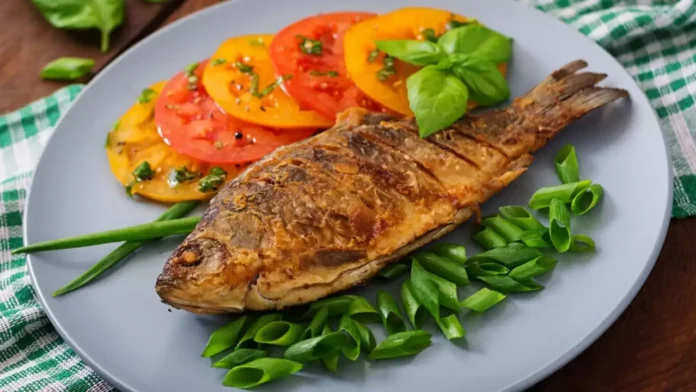According to a recent study conducted by WorldFish India, Indians are increasingly consuming fish, even in inland regions where it has not been a traditional dietary staple. This trend is attributed to rising incomes, evolving dietary preferences, and enhanced fish availability.
The surge in consumption, particularly among affluent consumers, can be attributed to the popularity of value-added products such as ready-to-cook meals and premium varieties like pomfret and lobster.
“If such options aren’t accessible, consumption won’t see an uptick,” explained Arun Padiyar, a specialist from WorldFish India and the primary author of the study.
Between 2005-06 and 2019-21, the percentage of individuals consuming fish rose from 66% to 72.1%, while annual per capita fish consumption increased from 4.9 kg to 8.9 kg. Data derived from National Family Household Surveys spanning the same period indicate that among fish consumers, per capita consumption surged from 7.4 kg to 12.3 kg.
Continue Exploring: Seafood companies boost investments in local market amid global export challenges: Shrimps, squids, and lobsters see surge in domestic demand
The northeastern and eastern states, alongside Kerala and Goa, continued to exhibit a strong preference for fish consumption. Tripura boasted the highest proportion of fish consumers at 99.35%, trailed by Manipur, Assam, Arunachal Pradesh, Nagaland, and West Bengal. Conversely, Haryana recorded the lowest percentage of fish eaters at 20.6% in 2019-21, followed by northern Punjab and Rajasthan.
Jammu and Kashmir experienced the most significant surge in fish consumption, with a 20.9% increase. Arun Padiyar attributed this notable rise in Kashmir to enhanced connectivity and the establishment of cold storage networks.
Following Jammu and Kashmir, Arunachal Pradesh witnessed a substantial increase of 15 percentage points, while Karnataka observed a rise of 10.1 percentage points. Additionally, consumption in the national capital increased by 8.7 percentage points.
The research also unveiled a rise in the frequency of fish consumption, with weekly intake showing an 11.3% increase. Kerala emerged as the region with the highest frequency of fish consumption, with over 50% of the population incorporating it into their daily diet, followed by Goa (36.2% daily consumption) and West Bengal (21.9%). Meanwhile, Assam and Tripura recorded the highest weekly consumption rates.
The study also noted a disparity in fish consumption between genders in the country. In 2019-21, approximately 78.6% of men consumed fish compared to 65.6% of women. This gender gap was narrower in states where fish consumption was more prevalent and frequent, such as Kerala. Padiyar suggested that this gap could be attributed in part to a higher proportion of men dining at hotels and restaurants compared to women. While urban areas exhibited higher fish consumption, including dining out, the analysis indicated that consumption in rural areas was growing at a faster rate.
Continue Exploring: ONDC and Fisheries Department sign MoU to foster market growth
Despite a general rise in non-vegetarian food consumption between 2005-06 and 2019-21, fish consumption continues to trail behind eggs and chicken. However, this gap is less pronounced in coastal states.
Interestingly, the study revealed a larger increase in weekly fish consumption among lower-income groups, possibly indicating improved availability and accessibility of fish. Over the same 15-year period, fish production in India more than doubled, reaching 14.2 million metric tonnes, with the majority being allocated for domestic consumption.
Much of the increase was attributed to the expansion of fish farming or aquaculture, encouraged by government schemes. According to a survey conducted by the National Council of Applied Economic Research (NCAER) last year, 56% of households cited increased availability and more variety as reasons for higher consumption.
“Push for fish farming can lead to a big boost for local consumption,” said NCAER senior fellow Saurabh Bandyopadhyay.
Continue Exploring: Govt launches INR 576 Crore aquaculture plan to transform northern states into sustainable shrimp farming hubs
Despite the increased domestic supply—India being the world’s second-largest producer of farmed fish—fish imports surged fivefold between 2005 and 2020, from 14,000 tonnes to 76,000 tonnes. Arun Padiyar suggested that these imports were probably comprised of value-added products like cleaned and deboned fillets tailored for high-end restaurants. According to the study, if current trends persist, annual per capita consumption could reach 16.1kg before 2050. Furthermore, the study highlighted the potential for this number to double with concerted efforts from both the government and private sectors.
When examining fish consumption on a global scale, India’s growth stood out as one of the highest within the World Bank group of lower-middle-income countries. In 2020, India’s per capita consumption slightly exceeded half of the group’s average of 14.9kg.
Continue Exploring: Andhra Pradesh’s Srikakulam district emerges as a global hub for shrimp exports, generating INR 10,000 Crore annually





